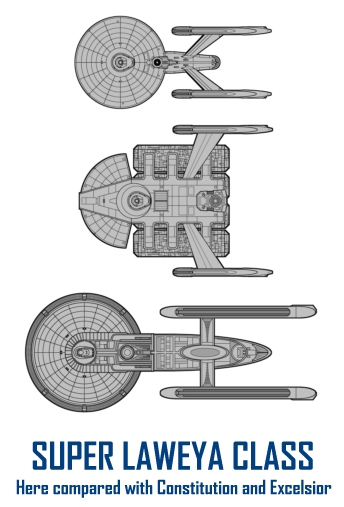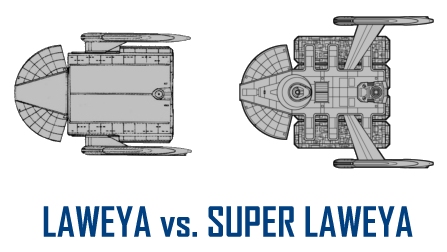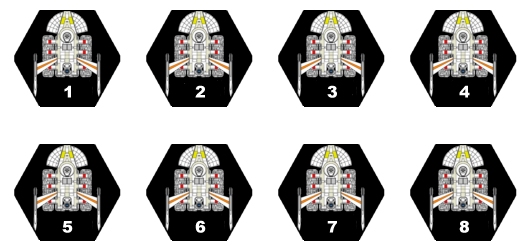|
2293 A.D: UPON SIGNING OF THE KHITOMER
ACCORDS, Starfleet Command conducted a thorough census of its
starlift capabilities, and issued a general commercial call for a
new Heavy Freighter design. A ship which might be fast-tracked
from the drawing board to the assembly line in under a year.
Due to the enormous burden soon to be placed on Starfleet
logistics—assisting in Klingon disaster relief and recovery,
following the Praxis event which precipitated the Khitomer
conference—the new Heavy Freighter would need to have rapid
deployment and re-deployment capacity. With minimal on-station
loiter required to accept or discharge cargoes.
At the same time, the USS Juratesh—a Laweya Class freighter
operating under a Starfleet merchant charter—had returned to the
Isratta shipyards which had produced her ten years before. Due
for standard refit and internal equipment overhaul, the Juratesh
was detached from Starfleet service and placed in the hands of
Isratta's prototype development department; the engineers
already having been deeply committed to a revamp of the basic Laweya
concept, even before Starfleet's Heavy Freighter announcement.
 Being an Andorian
conglomerate, Isratta corporation was highly motivated to capitalize
on the Laweya's extant service record. Seeing that the basic
spaceframe of the Juratesh was sound, Isratta stripped the Juratesh
down to her bones and began upgrading both her warp core and her
impulse deck; so as to better accommodate the dramatic increase in
cargo anticipated with the "trucking" concept Isratta's developers
had in mind. The keystone of which was a radically ambitious
plan for the upgraded Laweya to accept not just one, not just two,
but four uprated Starfleet commercial warp-capable container modules;
thousands of which were already in use across the Federation. Being an Andorian
conglomerate, Isratta corporation was highly motivated to capitalize
on the Laweya's extant service record. Seeing that the basic
spaceframe of the Juratesh was sound, Isratta stripped the Juratesh
down to her bones and began upgrading both her warp core and her
impulse deck; so as to better accommodate the dramatic increase in
cargo anticipated with the "trucking" concept Isratta's developers
had in mind. The keystone of which was a radically ambitious
plan for the upgraded Laweya to accept not just one, not just two,
but four uprated Starfleet commercial warp-capable container modules;
thousands of which were already in use across the Federation.
Inside of 90 days, the Juratesh's internal cargo space had
been done away with, and six cargo module docking pylons extended
laterally from the spaceframe's spine. At the same time, the
developers realized that doubling the ship's forward profile would
exceed the Laweya's prior navigational deflection capacity, so a
full navigational deflector dish assembly—similar to that used on
many other Starfleet vessels—was built on the underside of the
Juratesh's half-saucer primary hull.
At 120 days, with all major structural modifications
complete, the pre-scheduled overhaul of the Juratesh's living
spaces commenced, and an initial shakedown itinerary was formulated.
About this same time Starfleet issued an addendum to its
original Heavy Freighter call: given the sensitivity of the
newly-established treaty between the Klingon Empire and the
Federation—and the likelyhood of Starfleet logistics to encounter
rogue or breakaway Klingons refusing to cooperate with treaty
stipulations—the new Heavy Freighter was to be armed with a
compliment of phaser banks.
Again, being Andorians, Isratta's designers were only
too happy to equip the new Laweya upgrade—which had come to be
termed the Super Laweya, for Isratta internal accounting
purposes—with phaser weaponry. The Laweya's original, unarmed
design had proven vulnerable in several incidents prior to the
Khitomer conference, and Andorian merchant crews especially were not
eager to serve aboard ships unable to fight back against hostile
aggressors. Thus four banks of top-of-the-line phasers were
implemented to give coverage in all fields of fire.
When the Juratesh re-launched at 189 days from the
time of her initial dry-docking, she looked rather different from
the way she'd appeared upon refit receipt. The up-engined warp
core and impulse decks took several weeks of in-system and short
interstellar testing, before Juratesh could proceed at Warp 3
to a sister Isratta shipyard in a different solar system, and take
on her first two cargo modules.
Mating of the modules to the cargo pylons proved more
troublesome than anticipated. To the point that the first-run
design had to be modified, and the ship returned to her birth yard
for still more work. The cargo modules' mass exerted too much
strain on the grapple points, both during conventional impulse
travel, and when moving to warp speed. A series of "buffer
tube" extensions were added to the cargo pylons, with self-actuating
servos allowing just enough sympathetic motion that the cargo module
grapplers would not be damaged during normal cargo operations.
 Juratesh again warped to a nearby sister yard
for testing, after which the modified cargo grappling and docking
system was declared a success, and the Juratesh could enter
an official 90-day trial mission—working extant Starfleet logistics
corridors while using an Isratta company captain and crew, as well
as a team of developers onboard to deal with problems, rate the
Super Laweya's overall performance under normal duty conditions, and
gather as much promotional material as possible to presented to
Starfleet upon the trial mission's completion. Juratesh again warped to a nearby sister yard
for testing, after which the modified cargo grappling and docking
system was declared a success, and the Juratesh could enter
an official 90-day trial mission—working extant Starfleet logistics
corridors while using an Isratta company captain and crew, as well
as a team of developers onboard to deal with problems, rate the
Super Laweya's overall performance under normal duty conditions, and
gather as much promotional material as possible to presented to
Starfleet upon the trial mission's completion.
Enduring a few more minor teething problems with both engines and
cargo systems, the Juratesh eventually met her first real
test as a Super Laweya. Dispatched across the neutral zone, she was temporarily attached to a
Federation junket touring important worlds within the Klingon
Empire, so as to reassure the Klingons that both Starfleet Command
the Federation Council were making good on their promise to devote
every effort possible to the Klingon disaster recovery plan.
The Super Laweya (along with two other Heavy Freighter prototypes)
were thus shown off to Klingon fleet officers and civilian
officials, until—at 278 days from initial receipt for refit—the
Juratesh and her parent squadron of ships were set upon by a
squadron of rogue Klingons conducting raids on Starfleet logistics
operations being carried out within Klingon territory.
Both of the competitor Heavy Freighter designs
experienced problems with their defensive phaser arrays, and had to
retreat to the protection of the
Remora Class escorts and two
Chandley Class frigates providing junket security. But the
Super Laweya's weapons—meticulously tested and re-tested by the
Andorians—functioned flawlessly. Which enabled the Juratesh
to return defensive fire against several of the older-type Klingon
cruisers, while the escorts and frigates regrouped and drove off the
remaining renegades.
During the engagement, the captain and crew of the
Juratesh were credited with disabling at least one of the
renegade cruisers, which conducted a self-destruct rather than the
commander and crew face certain dishonorable trial (and death) in an
Imperial military court.
When Chancellor Azetbur herself sent a dispatch to
Starfleet Command, noting the Juratesh's staying power in an
unexpected fight, and thanking the junket for their overall
willingness to continue to support both the Klingon High Council and
the Khitomer Accords, Isratta immediately sent their sales team to
Starfleet procurement. With a full flight recording of the entire
incident, emphasizing the Super Laweya's sturdiness and
combat-worthiness, despite being freighted with four full cargo
modules, all of which dramatically decreased the ship's
maneuverability in emergency situations.
At 311 days from receipt for refit, the Juratesh
journeyed to Earth, where she moored at the mammoth Spacedock in
Earth orbit, and was officially re-commissioned into
Starfleet—accompanied by a contract to Isratta for a further 400
Super Laweya hulls, to be either refitted from extant Laweya hulls,
or built directly from factory components.
Anticipating the contract, Isratta had halted its
Laweya line forty five days earlier, and set about reconfiguring the
prior Laweyas half-finished for conversion and service as Super Laweyas. No less than a
dozen new Super Laweya ships were launched by the time a full 365
days had elapsed, from the Juratesh's receipt for
refit. And by the end of the first full year of Super Laweya
production, over five dozen hulls had been either commissioned or
re-commissioned (from Laweya refit) into Starfleet logistics and
merchant service. Many of them with primarily or even all-Andorian
crews, much to the delight of extant "Blue Fleet" officers operating
other Starfleet vessels of Andorian design and manufacture.
Production and refit would accelerate to at least 100
operational hulls per year, until the procurement contract (and
subsequent plussing up) with Starfleet Command had been satisfied,
and all commercial operators of the Super Laweya had similarly had
their orders fulfilled, too. In total, 724 Super Laweyas left the
Isratta production yards by 2302 A.D., at which time the Super
Laweya joined classes such as the
Liberty, Overfield,
and the older Cochrane,
being ubiquitous throughout Federation space. Especially the
Super Laweya's detachable cargo modules, many thousands of which
became permanent fixtures at space colonies along the frontier, or
were simply integrated into the architecture of space stations and
space platforms wherever such integration seemed expedient.
By 2309 A.D. Isratta began contemplating an upgade,
both to keep the successful Super Laweya production lines going, and
to extend the lifespans of extant Super Laweyas continuing to
operate under various commercial banners, and Starfleet proper. The
third iteration of the Laweya would make no radical alterations to
shape or structure (as had been the case with the original refit
experiment) but instead focused on strengthening the Heavy
Freighter's skeleton, as it pertained to the six cargo pylons, so
that a more robust, modern impulse deck could be mounted. The trial
runs of this third iteration demonstrated superior maneuverability,
even under full load, combined with better energy output, and the
Mark III entered production in 2311 A.D. with additional orders
having been received from prior customers. Including the great
majority of Mark II vessels being returned to the Isratta yards for
economy refit to the new specifications.
Like most Heavy Freighter designs, time and attrition
took their toll on the Super Laweya. By 2325 several hundred Laweya
and Super Laweya spaceframes had been destroyed, scrapped, or
mothballed. But Isratta recognized that the large number of Super
Laweyas still in service would provide at least twenty more years of
productive usefulness if given one more engine upgrade. This
time, not only was the superstructure improved to handle yet another
modernization of the impulse deck, but the warp core was overhauled
and modernized as well. Providing the Mark III refit with almost 20%
more total power than the Mark II, giving the Heavy Freighter even
better defensive effectiveness with its shields and phasers, not to
mention greater durability during freightline as well as contingency
combat operations.
The Super Laweya would thus remain in top Starfleet and
commercial service well into the 2340s, with the class only
gradually being retired in small batches; as larger, more powerful,
and more mission-capable Super Heavy Freighter designs began to be
developed. And the last Mark III Super Laweya would exit active
Starfleet commission in 2355, some six decades after the Juratesh
was first brought in for redesign by the Isratta team who originally
conceived of the Super Laweya refit.
It's estimated about 150 Super Laweyas remained in
Starfleet Reserve status from 2355 onward, with many more being used
for merchant training command, or were simply sold off to private
interests who could still get quality light-years out of an aging
(but proven) Heavy Freighter design. Including colonial consortiums
probing deep into the Beta Quadrant. So that by 2365 somewhere close
to 250 Super Laweyas were still gainfully employed to one degree or
another, or were kept interstellar-ready at Starfleet Reserve depots
throughout the Federation. Able to be rapidly crewed and activated
in case of emergencies. Such as the eventual invasion of the
Federation by the Borg, or the long and costly Federation war with
the Gamma Quadrant's Dominion. |
![]()



